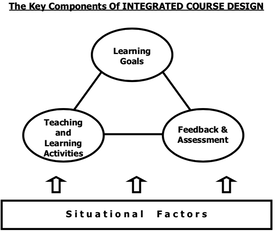My Teaching Views
 Fink, L. D. (2003). A self-directed guide to designing courses for significant learning. University of Oklahoma, 27, p11.
Fink, L. D. (2003). A self-directed guide to designing courses for significant learning. University of Oklahoma, 27, p11.
General Beliefs
After completing the Cognate in College Teaching at UNH, I believe that courses should be designed in an integrative fashion and should be focused on student learning. In an integrative course, all learning activities are geared towards students understanding the learning objectives and receiving feedback in regard to their progress; these three components are integrated into each other and enforce each other. The diagram to the right gives a visual representation of how this works.
In addition to designing integrative courses, I also believe that it is important to select teaching and learning activities with support from cognitive studies that focus on student learning. I want my students to take away the key concepts from my courses, to do so requires me to use different practices of presenting information and providing different opportunities for students to practice. As a few examples, I use the cognitive theory of multi-media learning to present information to students, I also try to incorporate retrieval practice into my recitation because it has been shown to have the strongest effect on learning. I also aim to interleave my material, so students are constantly being exposed to past material and can draw connections to the current material.
I have formalized my thoughts and beliefs about teaching into a teaching philosophy. Each semester, I try to update this document because I am constantly learning about teaching and learning and aim to provide the best educational experience for my students. In addition, I have also created a statement of teaching competency which details my best practices of teaching. For more details on my Teaching Philosophy and Teaching Competency Statement, please click on the buttons below.
After completing the Cognate in College Teaching at UNH, I believe that courses should be designed in an integrative fashion and should be focused on student learning. In an integrative course, all learning activities are geared towards students understanding the learning objectives and receiving feedback in regard to their progress; these three components are integrated into each other and enforce each other. The diagram to the right gives a visual representation of how this works.
In addition to designing integrative courses, I also believe that it is important to select teaching and learning activities with support from cognitive studies that focus on student learning. I want my students to take away the key concepts from my courses, to do so requires me to use different practices of presenting information and providing different opportunities for students to practice. As a few examples, I use the cognitive theory of multi-media learning to present information to students, I also try to incorporate retrieval practice into my recitation because it has been shown to have the strongest effect on learning. I also aim to interleave my material, so students are constantly being exposed to past material and can draw connections to the current material.
I have formalized my thoughts and beliefs about teaching into a teaching philosophy. Each semester, I try to update this document because I am constantly learning about teaching and learning and aim to provide the best educational experience for my students. In addition, I have also created a statement of teaching competency which details my best practices of teaching. For more details on my Teaching Philosophy and Teaching Competency Statement, please click on the buttons below.
Teaching Goals
I design all of my activities, course objectives, and provide feedback with these ultimate goals in mind.
My Teaching Goals are as follows:
My Teaching Goals are as follows:
- I want my students to leave the course with a deeper understanding of the key course concepts that they will remember for years after the course. (increase long-term retention of the material)
- I want to teach students how to learn by providing opportunities to practice meta-cognitive skills such as self-generated questions and self-explanation.
- I aim to provide feedback to students, based on the course objectives, for every activity to help students identify where they are in the learning process and to focus their studies
- I aim to design the presentation of material by following the Cognitive Theory of Multi-Media learning which aims at reducing extraneous load, managing essential load, and fostering generative processes (more detail in my teaching philosophy and statement of teaching competency)
- I aim to use a variety of teaching techniques that range in different levels of understanding to help students build their foundational knowledge, integrate previous knowledge with current knowledge, and apply the newly learned knowledge to problems
- I aim to create a significant learning environment that considers the diversity of students' backgrounds and experiences and engages students in the learning process. In addition to this, I also want to create an inclusive learning environment where everyone feels comfortable participating.
- Ultimately, I want to prepare my students for the real world by giving them an arsenal of knowledge and inducing problem solving skills
"Learning never exhausts the mind.”


